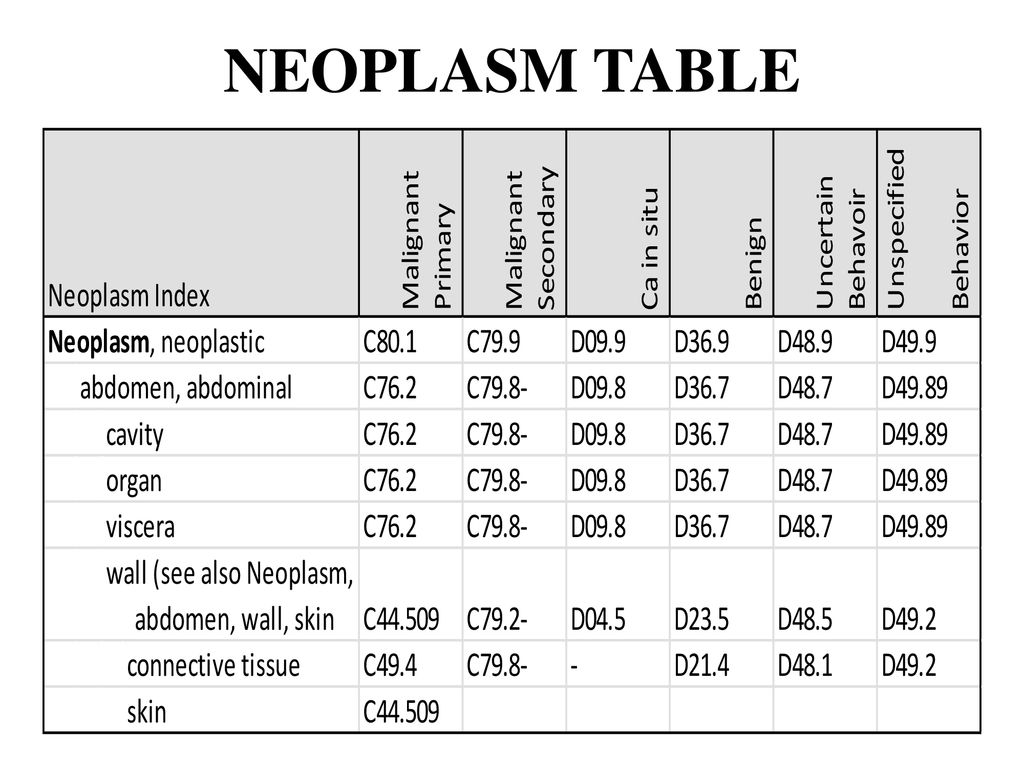Describe the Organization and Use of the Neoplasm Table
To properly code a neoplasm it is necessary to determine from the record if the neoplasm is benign in-situ malignant or of uncertain. This lesson focuses on clinical information and coding guidelines for all types of neoplasms.

World Health Organization Classification Of Myeloid Neoplasms With Download Table
Malignant primary is the secondary code reflecting the metastasis.

. The terms benign and malignant correlate to the course of the neoplasm. See the answer See the answer done loading. The process that occurs to produce a neoplasm is called neoplasia.
Cancer that has metasizedspread to a secondary site either adjacent or remote region of the body. While being diagnosed with a neoplasm or tumor sounds ominous its important to know that not all are cancerous. Moving to the right the following six columns show the suggested code in the following order.
The description of the neoplasm will often indicate which of the 6 columns is appropriate. The Neoplasm Table is set up as a seven-column table organized by the information in column 1the anatomical location of the tumor in alphabetic order. The remaining testicular neoplasms of diverse histologic types are rare and account for approximately 1 of all testicular neoplasms.
This lesson also explores the role of morphology codes and the use of V. Once you find the body part make sure youre at the highest specificity so we have intestine but we got lots of intestines and weve got small large so on and so forth. A benign neoplasm is a growth that does not have cellular features of cancer or precancer.
Malignant benign uncertain behavior and unspecified nature. The following six columns provide codes for malignant primary malignant secondary carcinoma CA in situ benign uncertain behavior and unspecified behavior for each anatomic site. Tumors are growths in any part of our body says Xavier Llor MD PhD a cancer geneticist and gastroenterologist who is the co-director of the Smilow Cancer.
The neoplasm table contains code numbers for neoplasms by anatomical site. Neoplasms C00-D49 The neoplasm chapter contains the codes for most benign and all malignant neoplasms. ICD-10 codes are organized not only by the Alphabetic Index and tabular list but by a neoplasm table table of drugs and chemicals and index to external causes.
The following terms wil be useful in understanding the table 1. For each site there are 6 possible code numbers according to whether the neoplasm in question is malignant benign in situ of uncertain behavior or of unspecified nature. Is located in the index under the main term and is organized by anatomic site.
The term neoplasm refers to the tumour mass itself. Benign neoplasms stay localized in one place. Up to 25 cash back The Neoplasm Table is arranged by anatomical site for each row and the type of histological behavior malignant benign uncertain behavior and unspecified is described across the columns.
Thats how you use the Neoplasm Table. A precancerous tumor has features of a malignant tumor. Cancer is a neoplasm that can grow rapidly spread and cause damage to the body.
So we have small intestine then we break it down. The first column lists the anatomic site or the neoplasm. To become neoplastic a normal cell must develop mutations that allow it to no.
CD-10 codes are organized not only by the Alphabetic Index and tabular list but by a neoplasm table table of drugs and chemicals and index to external causes. Further classified as to primary secoundary or carcinoma in situ. Describe how effective these tables can also be for healthcare professionals to locate accurate ICD-10-CM codes.
Emphasis will be on the use of the Alphabetic Index neoplasm table and determination of the primary and secondary sites of malignant neoplasms. Willis defined a neoplasm as an abnormal mass of tissue the growth of which exceeds and is uncoordinated with that of the surrounding normal tissues and persists in the same excessive manner after cessation of the stimuli which evoked the change. Youre going to first find the location the body part thats affected.
2022 ICD-10 Table of Neoplasms. When the only code that can be used is 1991 or if the morphology type is not given in the diagnostic explanation the coder uses 1991 as primary dx unless the site is one of the following. ICD-10-CM TABLE of NEOPLASMS.
These neoplasms are highly unlikely to become dangerous. Certain benign neoplasms such as prostatic adenomas maybe found in the specific body system chapters. Malignant neoplasms invade surrounding tissue and in most cases can metastasize to distant organs.
A tumor is a mass made up of cells that have divided abnormally. Neoplasia is new growth. Table 14B1 lists the classification of testicular and paratesticular tumors and tumorlike lesions as published in the most recent World Health Organization WHO book.
The list below gives the code numbers for neoplasms by anatomical site. Up to 24 cash back The Neoplasm table is ordered into columns. For each site there are six possible code numbers according to whether the neoplasm in question is malignant benign in situ of uncertain behavior or of unspecified natureThe description of the neoplasm will often indicate which of the six columns is.
The table below gives the code numbers for neoplasms by anatomical site. Coder uses the unknown unspecified site code on neoplasm table. It has not yet become cancer however and has not spread.
Describe how useful these tables can also be for healthcare professionals to locate correct ICD-10-CM codes.

Neoplasm Diagnosis Coding And Sequencing Ppt Download

Normal And Neoplastic Counterparts Of Histiocytic And Dendritic Cell Download Table

Neoplasms Icd 10 Cm Chapter 2 Codes C00 D49 Basicmedical Key

World Health Organization Classification Of Myeloid Neoplasms With Download Table
No comments for "Describe the Organization and Use of the Neoplasm Table"
Post a Comment